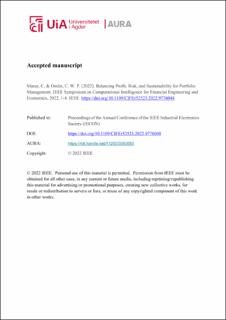| dc.contributor.author | Maree, Charl | |
| dc.contributor.author | Omlin, Christian Walter Peter | |
| dc.date.accessioned | 2023-03-28T10:51:16Z | |
| dc.date.available | 2023-03-28T10:51:16Z | |
| dc.date.created | 2022-09-15T15:31:21Z | |
| dc.date.issued | 2022 | |
| dc.identifier.citation | Maree, C. & Omlin, C. W. P. (2022). Balancing Profit, Risk, and Sustainability for Portfolio Management. IEEE Symposium on Computational Intelligence for Financial Engineering and Economics, 2022, 1-8. IEEE. | en_US |
| dc.identifier.isbn | 978-1-6654-4234-3 | |
| dc.identifier.uri | https://hdl.handle.net/11250/3060683 | |
| dc.description | Author's accepted manuscript | en_US |
| dc.description | © 2022 IEEE. Personal use of this material is permitted. Permission from IEEE must be obtained for all other uses, in any current or future media, including reprinting/republishing this material for advertising or promotional purposes, creating new collective works, for resale or redistribution to servers or lists, or reuse of any copyrighted component of this work in other works. | |
| dc.description.abstract | Stock portfolio optimization is the process of continuous reallocation of funds to a selection of stocks. This is a particularly well-suited problem for reinforcement learning, as daily rewards are compounding and objective functions may include more than just profit, e.g., risk and sustainability. We developed a novel utility function with the Sharpe ratio representing risk and the environmental, social, and governance score (ESG) representing sustainability. We show that a state- of-the-art policy gradient method – multi-agent deep deterministic policy gradients (MADDPG) – fails to find the optimum policy due to flat policy gradients and we therefore replaced gradient descent with a genetic algorithm for parameter optimization. We show that our system outperforms MADDPG while improving on deep Q-learning approaches by allowing for continuous action spaces. Crucially, by incorporating risk and sustainability criteria in the utility function, we improve on the state-of-the-art in reinforcement learning for portfolio optimization; risk and sustainability are essential in any modern trading strategy, and we propose a system that does not merely report these metrics, but that actively optimizes the portfolio to improve on them. | en_US |
| dc.language.iso | eng | en_US |
| dc.publisher | IEEE | en_US |
| dc.relation.ispartof | 2022 IEEE Symposium on Computational Intelligence for Financial Engineering and Economics (CIFEr) | |
| dc.title | Balancing Profit, Risk, and Sustainability for Portfolio Management | en_US |
| dc.type | Chapter | en_US |
| dc.type | Peer reviewed | en_US |
| dc.description.version | acceptedVersion | en_US |
| dc.rights.holder | © 2022 IEEE | en_US |
| dc.subject.nsi | VDP::Teknologi: 500 | en_US |
| dc.source.pagenumber | 1-8 | en_US |
| dc.source.volume | 2022 | en_US |
| dc.source.journal | IEEE Symposium on Computational Intelligence for Financial Engineering and Economics | en_US |
| dc.identifier.doi | https://doi.org/10.1109/CIFEr52523.2022.9776048 | |
| dc.identifier.cristin | 2052169 | |
| dc.relation.project | Norges forskningsråd: 311465 | en_US |
| cristin.qualitycode | 1 | |
